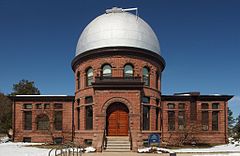Goodsell Observatory

Goodsell Observatory from the south
|
|||||||||||||||||||||||||||
| Organization | Carleton College | ||||||||||||||||||||||||||
|---|---|---|---|---|---|---|---|---|---|---|---|---|---|---|---|---|---|---|---|---|---|---|---|---|---|---|---|
| Code | 741 | ||||||||||||||||||||||||||
| Location | Northfield, Minnesota, USA | ||||||||||||||||||||||||||
| Coordinates | 44°27′43″N 93°09′09″W / 44.46194°N 93.15250°W | ||||||||||||||||||||||||||
| Altitude | 290 meters | ||||||||||||||||||||||||||
| Weather | See the Clear Sky Clock | ||||||||||||||||||||||||||
| Established | 1887 | ||||||||||||||||||||||||||
| Website | [1] | ||||||||||||||||||||||||||
| Telescopes | |||||||||||||||||||||||||||
|
|||||||||||||||||||||||||||
|
[]
|
|||||||||||||||||||||||||||
| John Brashear | 16.5-inch aperture refractor |
|---|---|
| Alvan Clark |
8.25-inch aperture refractor |
|
Goodsell Observatory--Carleton College
|
|
| Coordinates | 44°27′43″N 93°9′9″W / 44.46194°N 93.15250°WCoordinates: 44°27′43″N 93°9′9″W / 44.46194°N 93.15250°W |
| Area | Less than one acre |
| Built | 1887 |
| Architect | Harvey Ellis |
| Architectural style | Romanesque Revival |
| NRHP Reference # | 75001025 |
| Designated | May 12, 1975 |
8.25-inch aperture refractor
Goodsell Observatory is an observatory at Carleton College in Northfield, Minnesota, United States. It was constructed in 1887 and was, at the time, the largest observatory in the state of Minnesota. The Goodsell Observatory and its predecessor, a smaller observatory that opened in 1878, served as a widely consulted timekeeping station, bringing national prominence to Carleton College in the late 19th and early 20th centuries.
Goodsell Observatory was listed on the National Register of Historic Places in 1975 for its national significance in the themes of architecture, communications, education, engineering, literature, and science. It was nominated for being one of the nation's few intact 19th-century observatories (complete with a large collection of vintage scientific equipment); and for its critical timekeeping service, its association with scientific literature (founder William W. Payne also founded the journal Popular Astronomy), its fine Romanesque Revival architecture, and continuous use as a teaching facility. While the telescope sees use in astronomy classes, the building houses offices and a classroom used by Carleton's linguistics and environmental studies departments.
William W. Payne, one of Carleton's original professors, taught mathematics and natural philosophy, and established a course in astronomy during his first year at the college. The course grew into a program, and Carleton's president and board of trustees agreed to construct a small astronomical observatory on campus. It was Carleton's fifth building. Though small, the observatory housed instruments of the highest quality, including an 8 1⁄4-inch refractor by Alvan Clark & Sons and a 3-inch (7.6 cm) Fauth transit circle.
Shortly after the small observatory opened in 1878, a telegraph line was established from Carleton campus to central Northfield, and the observatory began transmitting a time signal at three minutes to noon each day. The signal was based on astronomical measurements and was picked up by cities throughout Minnesota, as well as area banks, jewelers, and the various railroad lines of the Northwest, including the Northern Pacific and the Great Northern. A U.S. Army Signal Corps station was placed at the observatory in 1881 and transmitted meteorological data to Washington, D.C. The facility also served as the headquarters of a state weather service from 1883 to 1886.
...
Wikipedia


